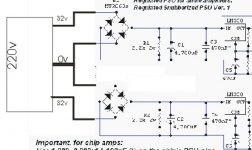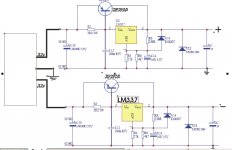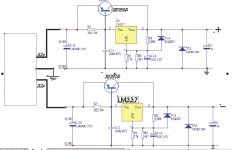Nuuk said:Again, I don't want to go into so much detail it looks like a University degree course. However, it is important to stress that a load must be connected to the bridge when taking the measurements. Hence the following quote from the section on testing! 😉
Yes a capacitor must be on the output but that is not a load. A load will consume a significant % of transformer current capacity, while a capacitor only filters, reduces ripple instead of being a load. Without a load you will only see peak output, though it is still a good thing, still important to know the peak voltage because it can't be allowed to exceed the capacitor, chipamp, or other parts' voltage ratings.
Then by knowing the peak it can be determined to be working and safe to hook up the amp, then with amp outputting to the speakers the actual load on the PSU can the load under which a second PSU voltage measurement is taken.
You can see some real life measurements here: http://www.diyaudio.com/forums/showthread.php?postid=1521340#post1521340
The transformer was 300VA, 2 x 22V AC Plitron.
The transformer was 300VA, 2 x 22V AC Plitron.
i have 2 25-0-25 100W toroidal transformer and i want to use one / channel.
i see a lot of design that use 0-25 transformers (without CT) wich will be the diference?
will be better to use 0-25 instead 25-0-25 ?
i see a lot of design that use 0-25 transformers (without CT) wich will be the diference?
will be better to use 0-25 instead 25-0-25 ?
Hi,
use either a dual secondary 0-25, 0-25Vac
or
a centre tapped secondary 25-0-25Vac.
A single secondary will give a single polarity supply and you then have to redesign your amplifier to operate from a single polarity supply. See the datasheet for details.
use either a dual secondary 0-25, 0-25Vac
or
a centre tapped secondary 25-0-25Vac.
A single secondary will give a single polarity supply and you then have to redesign your amplifier to operate from a single polarity supply. See the datasheet for details.
samsagaz said:i have 2 25-0-25 100W toroidal transformer and i want to use one / channel.
i see a lot of design that use 0-25 transformers (without CT) wich will be the diference?
will be better to use 0-25 instead 25-0-25 ?
0-25 transformers (without CT) will give you the option to use separate bridges, with CT it's not possible.
Depending on your setup, this may be advantage or not.
http://www.diyaudio.com/forums/showthread.php?s=&postid=331061&highlight=#post331061
Using 1 CT for each channel will improve anything? or just will loose my money doing that?
I want to use dual rectifiers, but i dont have 0-25 0-25 Secundary, i just have 2 CT 25-0-25.
I want to use dual rectifiers, but i dont have 0-25 0-25 Secundary, i just have 2 CT 25-0-25.
Dual mono does bring a definite improvement in my experience. If you already have the transformers, it won't cost you much more. 😉
Nuuk said:Dual mono does bring a definite improvement in my experience. If you already have the transformers, it won't cost you much more. 😉
wow, nice 🙂
btw, how can i measure if the gain and output power of both Mono amps are the same? :S
Need help:
I have transformer 32-0-32 ..5 Amperes... and wanted to use to "drive" my Gainclone, made by LM3886 (stereo version).
- If I use 40v capacitors can I get "normal" power supply for GC?(for example 36-37v per rail).
-Is there a schematics for regulated supply in which my transformer will fit? (Lt1083 or somethnig else..) to lower the supply on 35V per rail..
- No way - just to make single supply version (to use as 64V or twice by 32V?)
- Or...
I have transformer 32-0-32 ..5 Amperes... and wanted to use to "drive" my Gainclone, made by LM3886 (stereo version).
- If I use 40v capacitors can I get "normal" power supply for GC?(for example 36-37v per rail).
-Is there a schematics for regulated supply in which my transformer will fit? (Lt1083 or somethnig else..) to lower the supply on 35V per rail..
- No way - just to make single supply version (to use as 64V or twice by 32V?)
- Or...
Your transformer puts out 32V AC. Multiply by 1.4 and you get 44.8V DC. The maximum for the LM3886 is 42V. Also, using a 40V capacitor with 44.8V rails will cause destruction of the capacitor. The capacitor is not a limiter, it must be rated for higher than the highest voltage it will see.
A regulated supply is your best bet if you want to use that transformer. Unfortunately I can't help with that.
A regulated supply is your best bet if you want to use that transformer. Unfortunately I can't help with that.
pirej said:-Is there a schematics for regulated supply in which my transformer will fit? (Lt1083 or somethnig else..) to lower the supply on 35V per rail..
Check this thread: http://www.diyaudio.com/forums/showthread.php?threadid=56106&highlight=
Hi,
are you trying to get+-24Vdc from your regulators?
Then use a 24Vac or 25Vac transformer.
You need a single bridge rectifier if you use a centre tapped transformer.
You can use either a dual or a single bridge rectifier if you use a dual secondary transformer.
are you trying to get+-24Vdc from your regulators?
Then use a 24Vac or 25Vac transformer.
You need a single bridge rectifier if you use a centre tapped transformer.
You can use either a dual or a single bridge rectifier if you use a dual secondary transformer.
I'm trying to get 35v regulated as max. for stereo LM 3886.
The above schematic is OK with my trafo 32-0-32v?
The above schematic is OK with my trafo 32-0-32v?
- Home
- Amplifiers
- Chip Amps
- Chip amp power supply- a beginners guide


